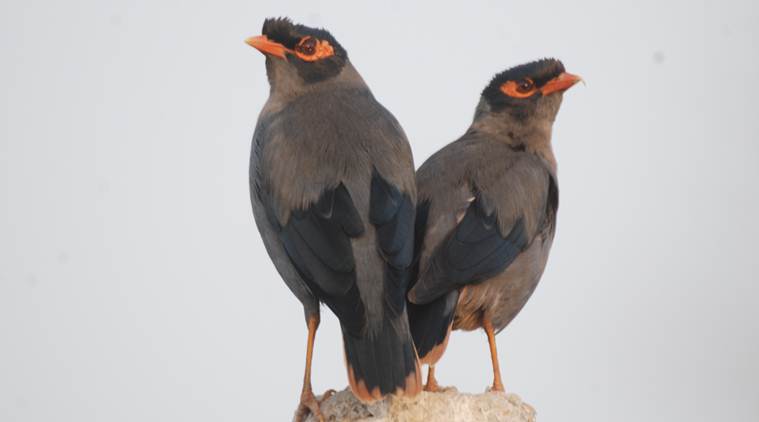Down in jungleland: The Railway Buffs
Bank mynas love the chaos and the crowds — they live life to the fullest and shout about their adventures while they’re at it.
 Both sexes dress alike. And boy, do they have attitude!
Both sexes dress alike. And boy, do they have attitude!
It was still dark at Gwalior railway station when we arrived there to catch our train back to Delhi, well before dawn, though, of course, there was none of the silence you usually associate with that normally tranquil hour. People yelled, the PA system rang out with announcements, trains thundered past and squealed to a halt, bogies banged into one another, and, of course, the ubiquitous chai sellers prowled up and down the platform, hawking their wares at top volume. But over this hubbub, my ears had caught another sound: a non-stop shrill chattering coming from somewhere distant… Could it be…?
It was. Gradually, the light improved, tingeing fleecy clouds pale pink and gold, and suddenly, the chattering grew clamorous and close. And there they were: clouds of bank mynas screeching across the sky in waves over the station, every bird screeching its head off! Several flocks flew over and around the station, their screeching drowning even the station clamour — which is really saying something. They wheeled and swirled in huge flocks and, finally, appeared to dissipate. Though they’re officially called “bank mynas”, they are also very appropriately known as railway mynas — because they really are true railway buffs.
These birds are slightly smaller than the common Indian myna and clad in a boiler-suit battleship grey outfit, beautifully set off by a brick red patch around and behind their eyes, which have ruby irises. They wear salmon-pink decals on their wings and their tails are frilled with the same colour. Their wings and heads are black — the head is glossy and with a tuft of feathers sticking up in front of the beak. Both sexes dress alike. And boy, do they have attitude!
They will saunter nonchalantly amidst waiting passengers, deftly snapping up spilled tidbits and namkeen (from virtually between your toes), or anything they consider edible. They will check out your luggage, perch on sacks of grain or catering carts, gobbling up what’s spilled out, they will zoom recklessly between narrow railway tracks — even as trains thunder past inches away from them — to pick up a tidbit a passenger has thrown out of a window. In the evenings, they will line up on the rafters and iron tresses of the locomotive sheds, impervious to the shunting, clanging and clamour all around, and shriek at the tops of their voices about what they had done that day — and the trains they had seen (and raided). I guess when you live in a major railway junction you need to have a loud voice.
They’re truly cosmopolitan birds and also love bazaars and markets — where grain and fruit is readily available. They are disarmingly unafraid of us and will saunter right up to your feet, knowing nothing will happen to them. They’ll raid fruit and grain stalls, cheekily filching what they can, with all the élan and nonchalance of schoolboys pulling a pigtail.
Bank mynas are usually found in north India — though they’re now going south too (possibly by train!) and are a feature of every north Indian railway station. But they also live out in the countryside, particularly in the neighbourhood of water bodies — lakes, rivers, canals, jheels and of course, crop fields. They get their name from their habit of nesting in tunnels which they excavate in earthen banks in large communal colonies. The tunnels slope slightly upwards (so that rainwater does not collect) for about a meter before expanding into a nursery chamber, which is furnished with straw, feathers and soft rubbish — and sometimes, swankily, with very glittery gift-wrapping paper! Mynas in cities reside in weep-hole apartments along the sides of bridges, flyovers and walls. Some choose holes in the steep inside walls of wells, where the only way out is to fly straight up — a choice that fledgling mynas before their first flight would find considerably daunting. (“Mama and papa must hate us! How can we fly straight up before we can fly at all? They just want us to fall into the water and be eaten by frogs or drown and get rid of us!”) Usually around three to five pale blue eggs are laid and both parents look after the brood, which fledge in around three weeks. The nesting season lasts between March and August, peaking in May and June.
Country-bumpkin bank mynas often hang around cattle herds, snapping up insects and grubs disturbed by the animals’ hooves and often hitch on to the animals’ ears, probing them for ticks and clinging on like bronco busting riders as the animals perambulate about and flick their ears. Similarly, they will follow a plough, quickly taking care of grubs and insects flushed out by its progress. With their omnivorous (and balanced, one has to say!) diet of seeds, fruits and insects — they are both a boon and a bane to farmers. While they can do a lot of damage to ripening crops of, say jowar, they are also excellent pest-controllers, devouring harmful insects. They roost in huge flocks along with other birds in groves of trees — again, creating a shrieking racket that needs to be heard to be believed. They really do seem to live and enjoy life to the fullest and love nothing more than shouting about it for the whole world to hear!
Their future seems secure, for surely any bird that can live in and around an Indian railway station or bazaar without going bonkers or having a nervous breakdown, has really got nothing to be afraid of. They seem to be able to take whatever life throws at them: a cacophonous railway junction or bazaar is as good a place to live as a quiet riverside and bovine habitat out in the country. As for me, while waiting interminably for the train to finally turn up, the bank mynas provided nonstop entertainment and amusement which helped to pass the time — and to think about writing this thank you note to them!





- 01
- 02
- 03
- 04
- 05






















